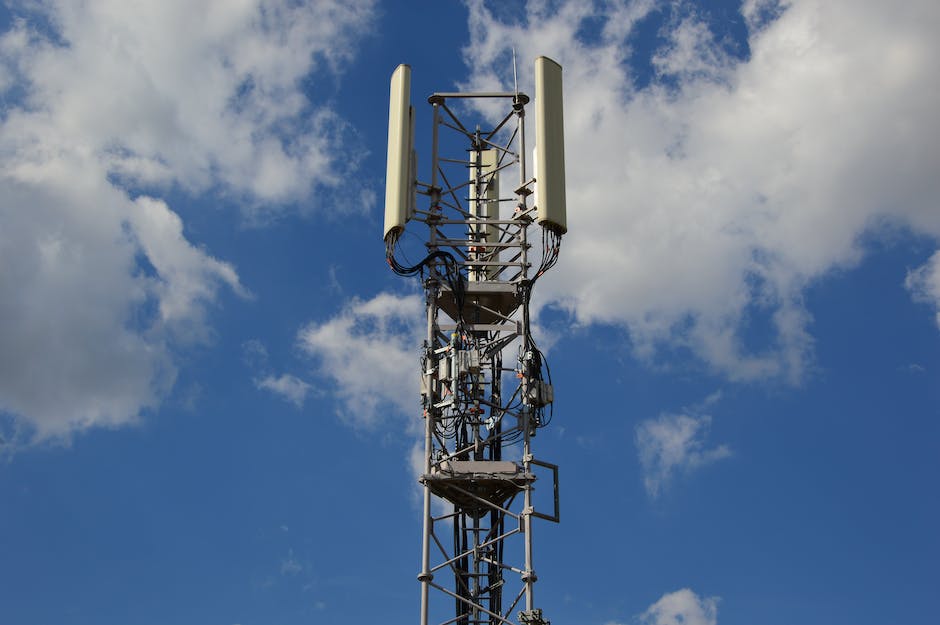Table of Contents
- Introduction
- The Role of 5G Technology in Transforming Business Leadership
- How 5G Technology Enhances Communication and Collaboration for Leaders
- The Potential of 5G Technology in Driving Innovation and Disruption in Leadership
- Understanding the Implications of 5G Technology on Leadership Decision-Making and Strategy
- Q&A
- Conclusion
Unleashing the Power of 5G: Empowering Leaders for the Future.
Introduction
Introduction:
Leaders in today’s fast-paced and interconnected world need to stay ahead of the curve when it comes to technological advancements. One such advancement that is set to revolutionize industries and societies is 5G technology. As the fifth generation of wireless technology, 5G promises lightning-fast speeds, ultra-low latency, and massive connectivity. However, the impact of 5G technology goes far beyond just faster internet speeds. Leaders need to understand the profound implications of 5G technology on various sectors, including healthcare, transportation, manufacturing, and communication. By grasping the potential of 5G, leaders can harness its power to drive innovation, enhance productivity, and create new opportunities for growth and development. In this article, we will explore why leaders need to understand the impact of 5G technology and how it can shape the future of their organizations and industries.
The Role of 5G Technology in Transforming Business Leadership

Why Leaders Need to Understand the Impact of 5G Technology
The Role of 5G Technology in Transforming Business Leadership
In today’s fast-paced and interconnected world, technology plays a crucial role in shaping the way businesses operate. One of the most significant technological advancements in recent years is the introduction of 5G technology. As leaders, it is essential to understand the impact that 5G technology can have on our organizations and how it can transform business leadership.
First and foremost, 5G technology promises to revolutionize connectivity. With its lightning-fast speeds and low latency, 5G will enable businesses to connect and communicate in ways that were previously unimaginable. This means that leaders will have access to real-time data and information, allowing them to make more informed and timely decisions. The ability to gather and analyze data in real-time can give leaders a competitive edge, as they can respond quickly to market changes and make strategic decisions based on accurate and up-to-date information.
Furthermore, 5G technology will enable the widespread adoption of the Internet of Things (IoT). The IoT refers to the network of interconnected devices that can communicate and share data with each other. With 5G, the IoT will become even more powerful, as it will be able to support a massive number of devices simultaneously. This opens up a world of possibilities for businesses, as they can leverage the IoT to streamline operations, improve efficiency, and enhance customer experiences. Leaders who understand the potential of the IoT and how it can be integrated into their organizations will be better equipped to drive innovation and stay ahead of the competition.
Another area where 5G technology can have a significant impact is in the realm of remote work. With the COVID-19 pandemic forcing many businesses to adopt remote work policies, the need for reliable and fast internet connectivity has become more critical than ever. 5G technology can provide the necessary infrastructure to support remote work on a large scale. Leaders who embrace remote work and understand how to leverage 5G technology to enable it will be able to attract top talent from around the world and create a more flexible and agile workforce.
Moreover, 5G technology can also transform business leadership by enabling the widespread adoption of emerging technologies such as artificial intelligence (AI) and virtual reality (VR). These technologies have the potential to revolutionize various industries, from healthcare to manufacturing. With 5G, AI and VR applications can be deployed and accessed remotely, allowing leaders to harness their power without the need for expensive on-site infrastructure. This opens up new possibilities for collaboration, training, and innovation, as leaders can leverage AI and VR to create immersive and interactive experiences for their teams.
In conclusion, leaders need to understand the impact of 5G technology on their organizations and how it can transform business leadership. From revolutionizing connectivity and enabling the IoT to supporting remote work and facilitating the adoption of emerging technologies, 5G has the potential to reshape the way businesses operate. By embracing 5G and staying ahead of the curve, leaders can position their organizations for success in the digital age. It is crucial for leaders to invest time and resources in understanding and harnessing the power of 5G technology to drive innovation, improve efficiency, and create a competitive advantage.
How 5G Technology Enhances Communication and Collaboration for Leaders
Why Leaders Need to Understand the Impact of 5G Technology
In today’s fast-paced and interconnected world, effective communication and collaboration are crucial for leaders to succeed. With the advent of 5G technology, these essential skills can be enhanced to a whole new level. This article will explore how 5G technology enhances communication and collaboration for leaders, and why it is imperative for them to understand its impact.
First and foremost, 5G technology provides leaders with faster and more reliable connectivity. With its lightning-fast speeds and low latency, leaders can communicate and collaborate in real-time, regardless of their location. This means that they can stay connected with their teams, partners, and clients, even when they are on the go. Whether it’s participating in video conferences, accessing important documents, or making critical decisions, leaders can do it all seamlessly with 5G technology.
Furthermore, 5G technology enables leaders to leverage advanced communication tools. With its increased bandwidth and capacity, leaders can take advantage of high-quality video conferencing, virtual reality, and augmented reality. These tools not only facilitate effective communication but also foster collaboration by creating immersive and interactive experiences. For example, leaders can conduct virtual meetings where participants feel like they are in the same room, enhancing engagement and productivity.
Another significant benefit of 5G technology is its ability to support the Internet of Things (IoT). With billions of devices connected to the internet, leaders can gather and analyze vast amounts of data in real-time. This data can provide valuable insights into various aspects of their business, such as customer behavior, supply chain management, and operational efficiency. Armed with this information, leaders can make informed decisions and drive innovation within their organizations.
Moreover, 5G technology enables leaders to embrace remote work and flexible work arrangements. With its reliable connectivity and advanced communication tools, leaders can effectively manage remote teams and ensure seamless collaboration. This flexibility not only enhances work-life balance for employees but also allows leaders to tap into a global talent pool. By embracing remote work, leaders can attract top talent from around the world and foster a diverse and inclusive workforce.
Additionally, 5G technology opens up new possibilities for leaders to connect with their customers. With its faster speeds and low latency, leaders can deliver personalized and immersive experiences to their customers. For example, augmented reality can be used to provide virtual product demonstrations or showcase how a product will look in a customer’s environment. This level of engagement not only enhances the customer experience but also drives brand loyalty and increases sales.
In conclusion, 5G technology has a profound impact on communication and collaboration for leaders. Its faster speeds, advanced communication tools, support for IoT, and flexibility enable leaders to stay connected, make informed decisions, manage remote teams, and connect with customers in innovative ways. Therefore, it is imperative for leaders to understand the impact of 5G technology and leverage its capabilities to drive success in today’s digital age. By embracing 5G technology, leaders can enhance their leadership skills, foster collaboration, and stay ahead of the competition.
The Potential of 5G Technology in Driving Innovation and Disruption in Leadership
Why Leaders Need to Understand the Impact of 5G Technology
The Potential of 5G Technology in Driving Innovation and Disruption in Leadership
In today’s fast-paced and interconnected world, technology plays a crucial role in shaping the way we live and work. One of the most significant technological advancements in recent years is the development of 5G technology. With its promise of faster speeds, lower latency, and increased capacity, 5G has the potential to revolutionize various industries and drive innovation and disruption in leadership.
First and foremost, 5G technology has the power to transform the way we communicate and connect with one another. With its lightning-fast speeds, 5G enables real-time communication and seamless connectivity, allowing leaders to stay connected with their teams and stakeholders regardless of their physical location. This level of connectivity can foster collaboration and enable leaders to make informed decisions quickly, leading to increased productivity and efficiency.
Furthermore, 5G technology opens up new possibilities for remote work and flexible working arrangements. With the ability to connect to high-speed networks from anywhere, leaders can empower their teams to work remotely, breaking down geographical barriers and enabling access to a global talent pool. This flexibility can lead to increased employee satisfaction and retention, as well as cost savings for organizations.
In addition to communication and connectivity, 5G technology has the potential to revolutionize industries such as healthcare, manufacturing, and transportation. For example, in healthcare, 5G can enable remote patient monitoring, telemedicine, and real-time data analysis, leading to improved patient outcomes and reduced healthcare costs. In manufacturing, 5G can enable the implementation of smart factories, where machines and devices can communicate with each other in real-time, optimizing production processes and reducing downtime. In transportation, 5G can enable autonomous vehicles and smart traffic management systems, leading to safer and more efficient transportation networks.
However, with the potential for innovation and disruption comes the need for leaders to understand the implications and challenges associated with 5G technology. One of the key challenges is the need for robust cybersecurity measures. With the increased connectivity and data exchange enabled by 5G, organizations are more vulnerable to cyber threats. Leaders need to prioritize cybersecurity and invest in technologies and processes to protect their organizations and stakeholders from potential breaches.
Another challenge is the need for leaders to adapt to the changing nature of work and the skills required in a 5G-enabled world. As technology continues to advance, leaders need to be proactive in upskilling themselves and their teams to leverage the full potential of 5G technology. This may involve investing in training programs, partnering with educational institutions, and fostering a culture of continuous learning within their organizations.
In conclusion, 5G technology has the potential to drive innovation and disruption in leadership. With its promise of faster speeds, lower latency, and increased capacity, 5G can transform the way we communicate, connect, and work. It opens up new possibilities for remote work, enables real-time collaboration, and revolutionizes industries such as healthcare, manufacturing, and transportation. However, leaders need to understand the implications and challenges associated with 5G technology, including cybersecurity and the need for upskilling. By embracing 5G and adapting to its impact, leaders can position themselves and their organizations for success in the digital age.
Understanding the Implications of 5G Technology on Leadership Decision-Making and Strategy
Why Leaders Need to Understand the Impact of 5G Technology
In today’s fast-paced and interconnected world, technology plays a crucial role in shaping the way businesses operate. One of the most significant technological advancements in recent years is the introduction of 5G technology. As leaders, it is essential to understand the implications of this technology on decision-making and strategy.
First and foremost, leaders need to grasp the potential of 5G technology to revolutionize communication and connectivity. With its lightning-fast speeds and low latency, 5G has the power to transform the way businesses communicate internally and externally. This means that leaders can expect faster and more reliable communication channels, enabling them to make quicker and more informed decisions.
Furthermore, 5G technology opens up a world of possibilities for innovation and disruption. With its ability to support a massive number of connected devices, leaders can explore new business models and revenue streams. For instance, the Internet of Things (IoT) can be fully realized with 5G, allowing businesses to collect and analyze vast amounts of data in real-time. This data-driven approach can lead to more accurate insights and predictions, enabling leaders to make data-informed decisions.
Another crucial aspect that leaders need to understand is the impact of 5G technology on customer experience. With faster speeds and lower latency, customers can expect seamless and immersive experiences across various touchpoints. This means that leaders must adapt their strategies to meet the evolving expectations of their customers. For example, businesses can leverage augmented reality (AR) and virtual reality (VR) technologies to create engaging and personalized experiences. By understanding the potential of 5G, leaders can stay ahead of the competition and deliver exceptional customer experiences.
Moreover, leaders need to be aware of the security implications that come with 5G technology. As more devices become connected, the risk of cyber threats increases. Leaders must prioritize cybersecurity and invest in robust measures to protect their organizations and customers. By understanding the vulnerabilities and risks associated with 5G, leaders can develop comprehensive security strategies and ensure the integrity of their operations.
Additionally, leaders need to consider the regulatory and policy landscape surrounding 5G technology. As governments and regulatory bodies grapple with the implications of this technology, leaders must stay informed and adapt their strategies accordingly. Understanding the legal and ethical considerations of 5G is crucial to ensure compliance and maintain trust with stakeholders.
Lastly, leaders must recognize the potential challenges and limitations of 5G technology. While it offers numerous benefits, it is not without its drawbacks. For instance, the infrastructure required for 5G deployment can be costly and time-consuming. Leaders need to carefully assess the feasibility and return on investment of implementing 5G technology in their organizations. By understanding the limitations, leaders can make informed decisions and allocate resources effectively.
In conclusion, leaders need to understand the impact of 5G technology on decision-making and strategy. From revolutionizing communication to enabling innovation and enhancing customer experiences, 5G has the potential to reshape the business landscape. However, leaders must also be mindful of the security, regulatory, and financial implications that come with this technology. By staying informed and adapting their strategies, leaders can harness the power of 5G and drive their organizations towards success in the digital age.
Q&A
1. Why do leaders need to understand the impact of 5G technology?
Leaders need to understand the impact of 5G technology to make informed decisions about its implementation and potential benefits for their organizations.
2. What are the potential benefits of 5G technology for leaders?
Potential benefits of 5G technology for leaders include faster and more reliable connectivity, improved data transfer speeds, enhanced IoT capabilities, and the ability to leverage emerging technologies like AI and automation.
3. How can understanding the impact of 5G technology help leaders stay competitive?
Understanding the impact of 5G technology can help leaders identify new business opportunities, streamline operations, and deliver innovative products and services, thereby staying competitive in a rapidly evolving digital landscape.
4. What risks should leaders be aware of when it comes to 5G technology?
Leaders should be aware of potential cybersecurity risks, data privacy concerns, and the need for robust infrastructure to support 5G technology. Additionally, they should consider the potential impact on existing business models and workforce dynamics.
Conclusion
In conclusion, leaders need to understand the impact of 5G technology due to its potential to revolutionize various industries and drive economic growth. By comprehending the capabilities and implications of 5G, leaders can make informed decisions, develop effective strategies, and harness the full potential of this transformative technology for the benefit of their organizations and societies as a whole.




